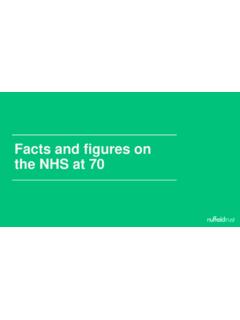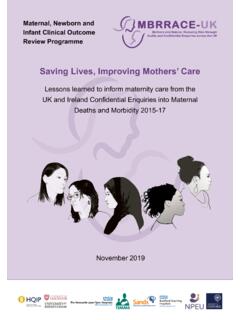Transcription of OBESITY in SCOTLAND OBESITY IN SCOTLAND Briefing
1 BriefingDefinitionFactsOBESITY IN SCOTLAND } OBESITY is defined as Body Mass Index over 30 kg/m2, which records weight adjusted for height } OBESITY is a serious public health threat in SCOTLAND : affecting one in every four adults and almost one in five children }Two in every three adults in SCOTLAND (65%) are overweight; people of normal weight in SCOTLAND are now in the minority } OBESITY rates in SCOTLAND are amongst the highest in the world, even higher than in England }The current OBESITY crisis results from living in obesogenic environments: where relative inactivity and overconsumption of energy dense foods is too available, affordable and accepted }Although personal choices are important, obesogenic environments create dangerously high levels of OBESITY in the population } OBESITY harms many aspects of health.
2 It interferes with sexual function, breathing, mood and social interactions } OBESITY also shortens life, increasing deaths from type 2 diabetes, heart disease and common cancers }In SCOTLAND , OBESITY reduces productivity and physical activity; it increases sickness absence, and demand for health and social care services }The cost of OBESITY to the NHS in SCOTLAND is huge, estimated between 360 million and 600 million annually232 - 242 St Vincent StreetGlasgow G2 5RJ 221 6072 @ a population level, overweight and OBESITY are usually defined using Body Mass Index (BMI). BMI is a measure of whether a person is a healthy weight for their height.
3 For most adults a BMI of 25 kg/m2 is overweight and BMI over 30 kg/m2 is , calculated from a person s height and weight, is the most effective population measure available as it is relatively accurate, simple and cheap for large population groups. However, there will always be exceptions to the rule; for example, people who are very muscular and pregnant women will be quite heavy for their height with a high BMI, but will not have the health risks of carrying extra fat mass. In such individual circumstances other measures can be used to provide a more accurate assessment of healthy weight in kgyour height in metresDivide your answer again by your height in metres ()Calculate your BMIOBESITY in SCOTLANDJuly 2016 Monitoring OBESITY in ScotlandCarried out annually, the scottish Health Survey1 provides a detailed picture of the health of the scottish population.
4 Each year the survey provides BMI data for adults and Child Health Reviews2 which include height and weight are undertaken in Primary 1 (age 4 to 6) covering 92% of that population group. The resulting statistics report BMI England the National Child Measurement Programme3 measures height and weight at reception (age 4 to 6) and year 6 (age 10 to 11).Overweight and OBESITY in SCOTLAND }Two in three (65%) adults aged 16-64 are overweight or obese (had BMI over 25)1 }More than one in 4 adults are obese (28% had BMI over 30)1 }Between 1995 and 2014, the proportion of adults categorised as obese (BMI 30+), increased by half, from to 28%1 }Since 1995, the proportion of the population which was overweight or obese (BMI 25+) increased from to 65%1 }Women have higher OBESITY rates than men (29% compared with 26%)1 } OBESITY increases with age, with almost 35% of men and 37% of women in the 65-74 age group being obese1 } OBESITY does not affect everyone equally.
5 Rates are higher in areas of greater deprivation, particularly among women1, children2, older age groups, black and minority ethnic groups, and people with OBESITY in SCOTLAND }In 2014, 31% of children in SCOTLAND (aged 2 to 15) were at risk of overweight or OBESITY ; of which 17% were at risk of OBESITY and 14% at risk of overweight1 }In 2014/15, almost 22% of Primary 1 children (aged 4 to 6) were at risk of overweight or OBESITY ; of which 10% were at risk of OBESITY and 12% were at risk of overweight; this was slightly less than in 2005/6 ( and respectively), however these high rates have persisted relatively unchanged over the last decade2 }The proportion of healthy weight Primary 1 children has not improved in the last 10 years (in 2007/8 and 2014/15 it was 77%)
6 2 }Children in SCOTLAND living in two most deprived quintiles, are least likely to have healthy weight1 }In 2014/15 in the least deprived areas 17% of Primary 1 children were classified as at risk of overweight and OBESITY compared to 25% in the most deprived areas2 OBESITY in Pregnant WomenProvisional 2015 data indicates that 21% of pregnant women in SCOTLAND are obese at their first antenatal booking, with a further 28% classified as 2 Diabetes: Fat cells in the body, especially from fat tissue around waist, produce hormones and proteins that interfere with body s cardiovascular and metabolic systems, increasing risk of type 2 diabetes.
7 Obese women are 13 times more likely to develop type 2 diabetes than normal-weight women14. 47% of type 2 diabetes is attributable to obesity1511 Common Cancers: breast, womb (endometrial), bowel, pancreas, oesophageal, kidney, ovarian, prostate, gallbladder, liver and stomach. Hormones and proteins produced by fat cells are released into the bloodstream and carried around the body to many organs increasing the cancer risk16. 29% of colon cancers, 14% of endometrial, 13% ovarian, 3% prostate and 1% rectal cancers are attributable to obesity15 Cardiovascular disease: hypertension, atherosclerosis, heart failure, ischaemic heart disease, ischaemic stroke.
8 OBESITY increases the risk of cardiovascular disease through causing high blood pressure and type 2 diabetes. 36% of hypertension, 18% myocardial infarction, 15% angina pectoris, and 6% of strokes are attributable to obesity15 Alzheimer s disease26 and dementiaGastrointestinal disorders: gallstones, pancreatitis, liver disease, gastro-oesophageal reflux disease, irritable bowel syndrome. Gastrointestinal disorders are 2 to 3 times more common in obese individuals than in people of normal weight17. 15% of gallstone cases are attributable to obesity15 Infertility in women and impotency in men18. Losing weight improves women s chance of getting pregnant and in men improves hormone imbalance and erectile dysfunction19 Complications during pregnancy and birth: miscarriage, gestational diabetes, high blood pressure and pre-eclampsia, blood clots, baby s shoulders becoming stuck during labour, heavier than normal bleeding after birth4,20 Musculoskeletal problems: gout, osteoarthritis, and lower back pain are caused by the mechanical and/or metabolic strain of excess fat mass on the bones.
9 47% of gout and 12% of osteoarthritis are attributable to obesityMental health problems: depression, bipolar disorder and anxiety are associated with obesity21. Mechanisms are still being investigated and could include higher inflammation levels, insulin resistance, hormonal changes and social and cultural factors22 Respiratory disorders: asthma, chronic obstructive pulmonary disease, obstructive sleep apnoea are caused by mechanical factors and metabolic pathways related to obesityKidney disease23 Premature death: OBESITY reduces life expectancy by an average of 3 years; severe OBESITY (BMI > 40) reduces it by 8-10 years24 Unemployment4 Discrimination and stigmatisation4 Increased risk of hospitalisationSeverely obese people (BMI > 40) have been found to be 3 times more likely than those of healthy weight to need social care4 Impact of ObesityObesity can have a negative impact on health as well as other aspects of life for adults and children reducing their overall quality of life.
10 OBESITY increases the risk of:Additional Risks for Obese ChildrenEmotional and behavioural impacts: stigmatisation, bullying, low self-esteem, and school absence4 Breathing difficulties, increased risk of fractures, hypertension, early markers of cardiovascular disease, insulin resistance and psychological effects27 Risk becoming obese adults4 Higher risk of morbidity, disability and premature mortality in adulthood21. of ObesityObesity, understood as the accumulation of excess body fat, occurs when energy intake from food and drink is greater than the body s energy requirements over a prolonged period. An obesogenic environment promotes weight gain, acts on individual biology and psychology influencing individual lifestyles.






